Maund on Gold & Silver
Gold Market Update
The action in gold on Thursday and especially on Friday was bullish, as well it might be after a near vertical drop of nearly $200 in just 2 weeks. In the article At what point does gold become a full blown bearmarket?posted on the site on 23rd it was made clear that the strong support in the $700 area needed to hold, otherwise gold would join copper and silver and many other commodities in being a bearmarket, at least as far as its paper price is concerned. Immediately after this article was posted gold dropped further to test this support, but on both Thursday and Friday it refused to close below $700, and on Friday a bullish candlestick, a long-legged doji, otherwise known as a "Rickshaw Man" showed up on the chart. This type of candlestick shows wild indecision and when it occurs after a severe decline it indicates that the bears are losing control. The appearance of this type of candlestick on the long US T-Bond chart in mid-September enabled us to predict the savage reversal that set in 2 days later. Note that while we could see several more days like Friday, the appearance of this doji on the gold chart after a particularly brutal decline is an indication that a temporary reversal is probably close at hand. Short-term oscillators are certainly supportive of a reversal soon, for as we can see on the 6-month chart both the RSI and MACD indicators are showing gold to be deeply oversold and very close to being critically oversold.
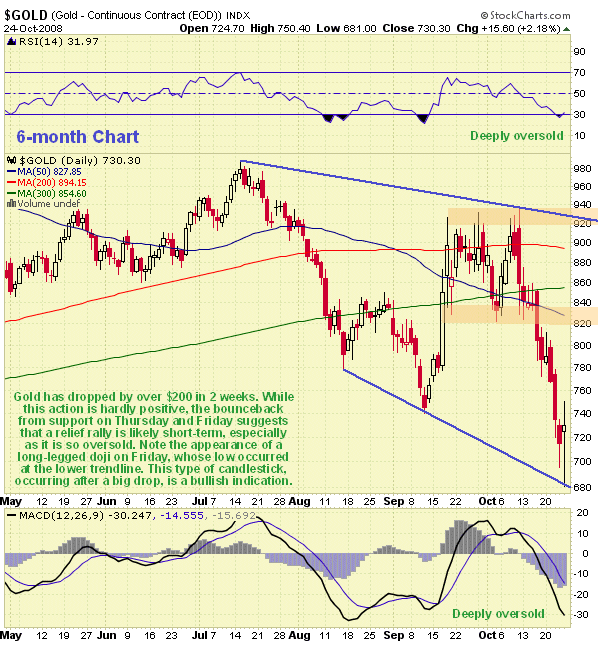
While our long-term gold chart, which shows the bullmarket in its entirety, definitely shows deterioration, with the gold price dropping way below its long-term moving averages, which are now rolling over, we can also see that gold has now fallen back into a zone of strong support that has the capacity to generate a significant rally immediately the adverse factors ease and in looking at this chart it is important to keep in mind the distortion arising from the extraordinary strength of the dollar.
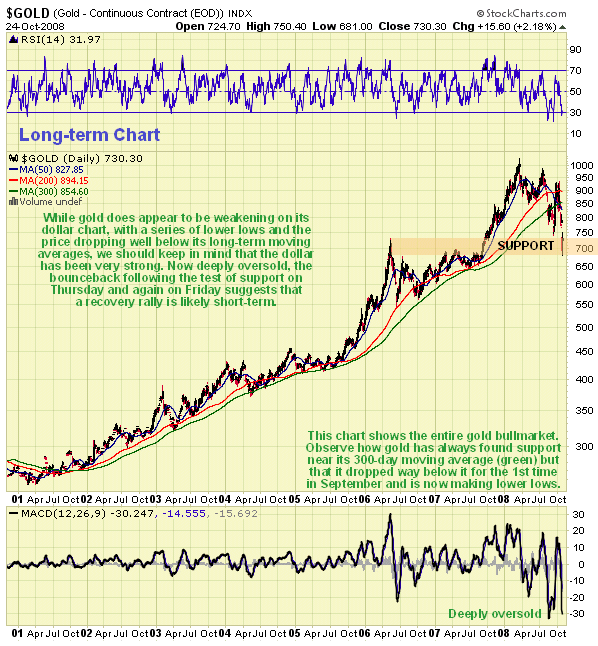
The best way to strip out the effect of the rocketing dollar is of course to plot gold against the Euro, and see what that looks like. As we can see, gold looks reasonably healthy on the Euro chart and is back in buying territory having fallen to the important trendline support shown. On the Euro chart gold's long-term uptrend is intact and long-term moving averages are still rising.
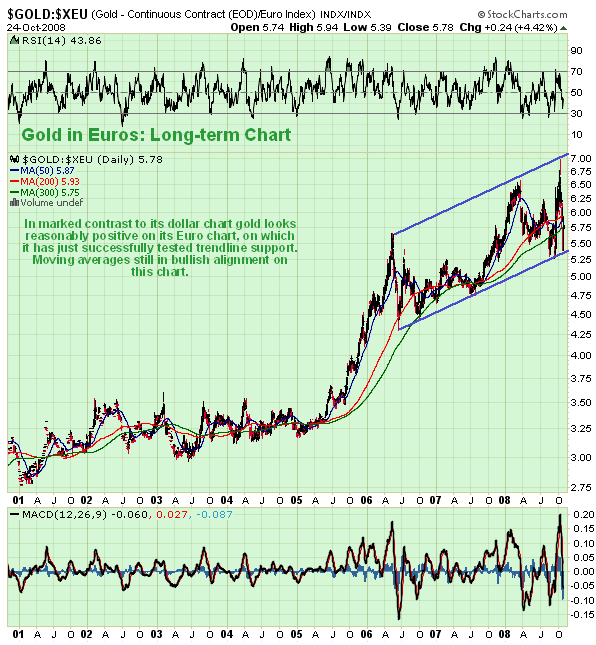
One of the supreme advantages that the United States enjoys compared to the European Union is that it is one country, whereas the EU is an affiliation of countries run by a ramshackle committee with all the blundering inefficiency that inevitably results from that. The attitude of the politicians representing the individual countries in the EU is the complete opposite of the spirit expressed by John F Kennedy in his inspiring if somewhat idealistic statement "Think not what your country can do for you, but what you can do for your country". Their attitude is summed up by the expression "Think not what we can do for the EU, but how much the EU can contribute to our coffers". This is a big reason why the avalanche of funds cascading out of commodities and stocks as a result of forced liquidation has flowed either into US dollars or into short expiry US Treasuries - short because even if the US goes completely down the drain, it isn't likely to happen in 3 months time. To buy Treasuries you need dollars, hence the massive dollar spike. The dollar is not intrinsically strong of course, quite the contrary with the continued explosion in the money supply to fund various bailouts including the Paulson Plan junket. What this means is that immediately the blind panic out of commodities and stocks stops and fund managers and investors generally start to gravitate back towards these markets, the music will suddenly stop for the dollar which can be expected to go into a violent reversal, at which point gold is likely to soar, and even shell-shocked silver is likely to recover. Traders should look out for this. Amazingly, the dollar spike we are now witnessing was predicted in articles by George Paulos and Sol Palha and by Rick Ackerman as much as 5 years ago to occur in just such circumstances and they further predicted that the dollar would collapse back after just as fast, or even faster.
Right now though, as you won't need reminding, the dollar is on a tear. It paid scant regard to the "Distribution Dome" and the channel we had delineated in the last update, instead blasting through them and rising vertically so that it is now critically overbought and has also opened up a huge gap with its moving averages. This suggests at the least consolidation before further gains, and more probably near-term reaction, made more likely by the perky action in gold on Friday. Failure of the lower channel line, now a long way below the index, will be viewed as an indication that the spike is over and this would open up the risk of a plunge, and a corresponding strong rise in gold and silver.
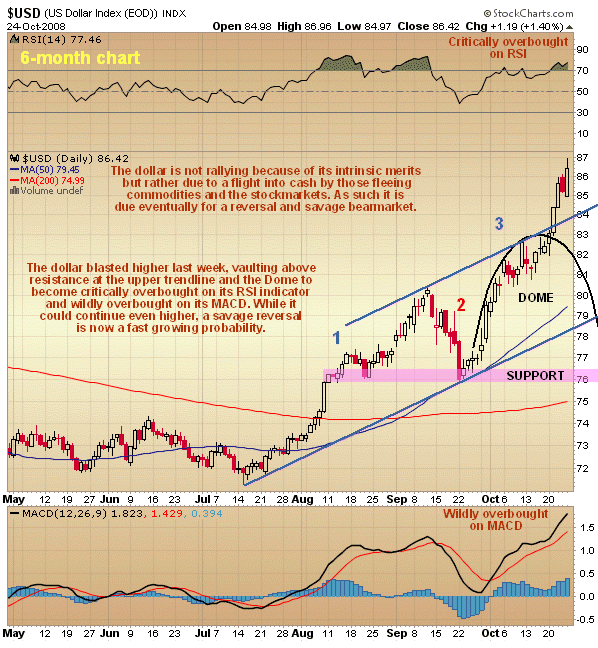
End-of-the-worlders have recently been on a spree buying up physical gold and silver, especially coins and have exhausted supply in many places, driving up premiums. This is what makes the continued drop in prices on the paper markets seem so odd. Charges of manipulation abound, but it could simply be that the massive indiscriminate forced liquidation of gold by funds far outways physical buying, although the absorption of available physical supply is clearly a bullish influence. Much of the physical buying of gold has been motivated by fear of complete failure of the banking system, which we have actually come close to. However low your opinion of banks it is clear that failure of the banking system is unthinkable as it would mean the collapse of civilization. This is why governments all over the world are stepping forward to guarantee funds in banks to stop bank runs and where necessary are nationalizing banks. Whether this succeeds in stopping the rot remains to be seen, for they have to contend with the monstrous derivatives mess which could yet overwhelm their plans.
Amongst the rumors and stories that surfaced late last week was one that a huge multi-million $ off-market purchase of physical gold took place in Toronto with the buyer paying $1075 per ounce. The veracity of this isn't known, but if true it is clearly a positive sign for the gold market. Another is that General Motors, an American icon, is about to file for bankruptcy. The effect of this, if true, might be the opposite of one might expect, for while the psychological shock of this development could be expected to cause the broad stockmarket to nosedive, it may have already been largely discounted, so that the effect is a feeling of relief that they have finally "bitten the bullet", which would probably not be shared by those working on the production line.
Silver Market Update
If we define a bearmarket as the price making a series of lower intermediate lows beneath falling long-term moving averages, then silver is in a bearmarket against the dollar and against the Euro and most other currencies. It is worth recalling, however, that by this definition both gold and silver lapsed into bearmarkets in the mid-1970's, which turned out to be severe corrections in the middle of a major bullmarket, as in the late 70's they picked up again and accelerated into spectacular parabolic blowoff tops.
Fundamentally, if the "authorities", that is the people who were responsible for creating or permitting the current financial shambles, manage to get a handle on things and stabilize the banking system sufficiently so that they can concentrate fully on their favorite pastime of printing money, and assuming they can navigate their way through the derivatives minefield, then both gold and silver are likely to resume an upward trajectory. For now though, the silver market is very much on the defensive, as shown by the price retreating ever lower beneath a falling 50-day moving average, despite it being obviously deeply oversold and just above important support which in favorable conditions has the capacity to generate a strong bounce. An ugly reality of the silver market is that it has been behaving more like a base metal than a Precious Metal in the recent past.
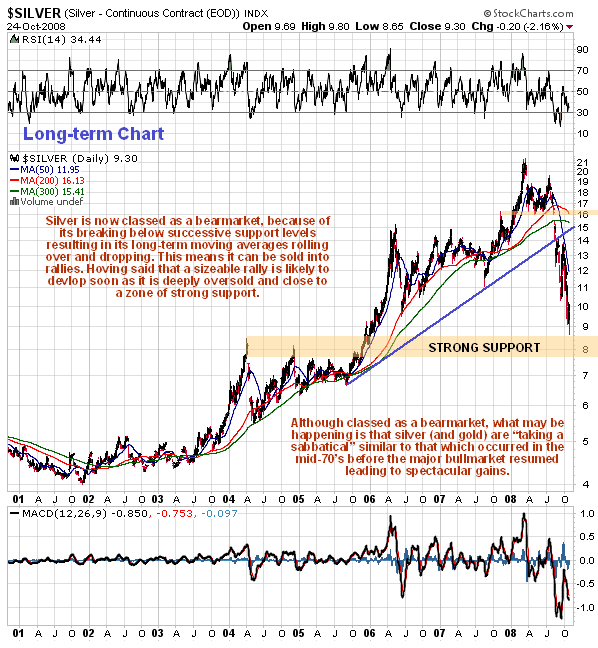
On the long-term chart we can see how silver has crashed successive support levels, down to and including the important Summer 06 low, which has not surprisingly had the effect of swinging its long-term moving averages into bearish alignment. However, it is now deeply oversold relative to these moving averages and arriving at a zone of strong support which is likely to generate a strong bounce in favorable market conditions such as would be occasioned by a dollar reversal.
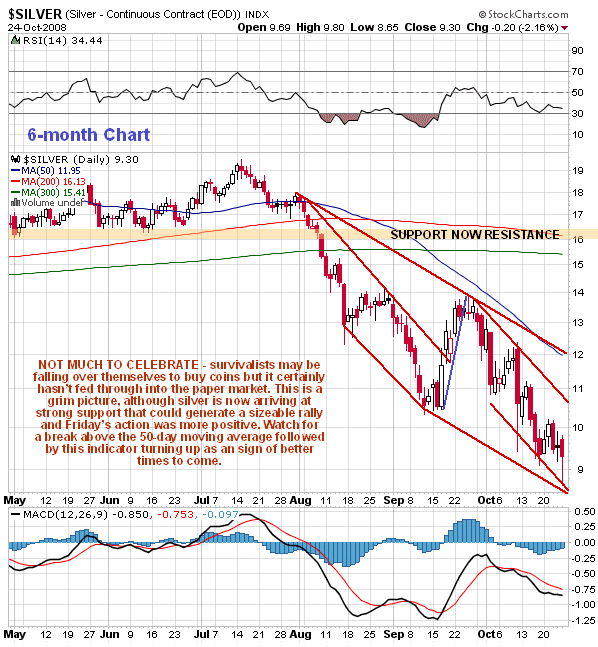
The 6-month chart shows in detail the savage downtrend that followed failure of the key $16 support level. A sign of an improvement in fortunes for silver will be the price breaking above its 50-day moving average (blue line) and this indicator subsequently turning up.
There is a lot of talk doing the rounds that the paper market, especially the Comex, is heavily manipulated and suppressed and that this is the reason for the big premiums for physical silver that currently exist, for both bars etc and coins. If this is true then we can expect a thriving black market to spring up that renders the paper markets increasingly irrelevant, or forces them to close up the gap. It could be argued, however, that the large premiums are due to a hard core of survivalists buying physical in expectation of a banking collapse, and if this doesn't happen, probably because of many banks being nationalized, then these premiums will subsequently ease.
Clive Maund, Diploma Technical Analysis
support@clivemaund.com
www.clivemaund.com
Copiapo, Chile

















